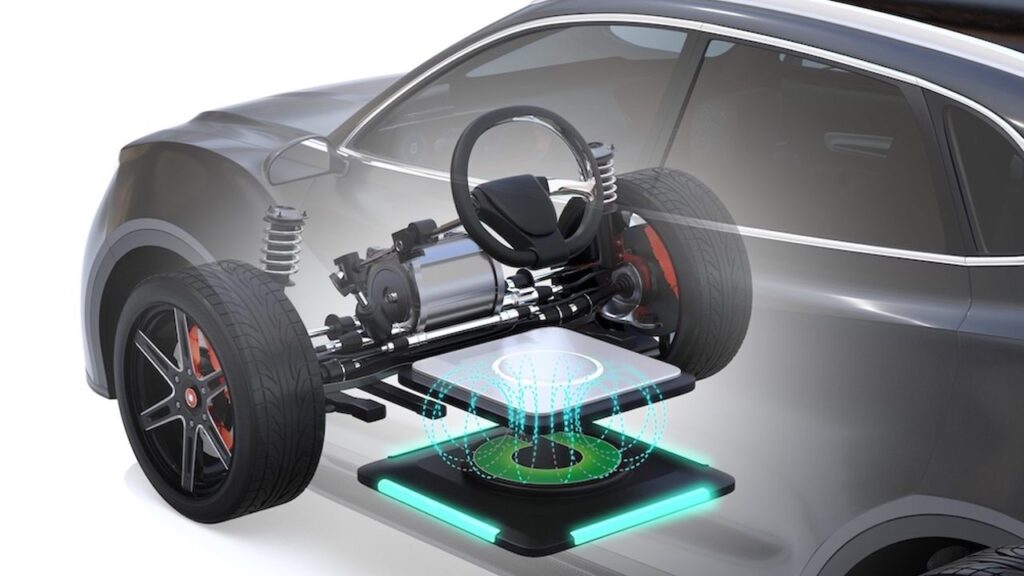The future of EVs encompasses the integration of numerous innovative technologies within the swiftly advancing charging infrastructure. Inductive charging, or wireless charging, is a pivotal element in this evolution.
With the rapidly expanding growth in the sales of EVs, charging stations have become ubiquitous. Now, imagine your electric car silently replenishing its battery as you seamlessly glide down the highway, or even topping up while parked at a red light. This futuristic scenario isn’t science fiction; it’s the promise of inductive charging, a technology poised to revolutionize the way we power our EVs.
At the heart of inductive charging lies a scientific principle called electromagnetic induction. Picture a playground seesaw: push down on one side, and the other end rises. Similarly, when an alternating current is passed through a coil in the ground (known as the transmitter), it generates a magnetic field. This invisible force, in turn, induces a current in another coil (the receiver) mounted on the underside of the EV. This induced current then flows back to the battery, charging it wirelessly.

You might also like: Fiat 500e To Be First Stellantis EV To Get Battery-Swapping Technology
Types of Inductive Charging in EVs
- Static Inductive Charging: This is the more familiar setup, akin to wireless charging your smartphone. The EV parks over a stationary charging pad, and the energy transfer begins. While convenient for home and public charging, this method limits EV movement during the process.
- Dynamic Inductive Charging: This is where the true magic unfolds. Imagine embedded charging segments seamlessly integrated into roads or highways. As an EV drives over these segments, the magnetic field continuously transfers energy to its battery, keeping it topped up on the move. This eliminates the need for dedicated charging stations and empowers the continuous operation of vehicles like electric buses and taxis.
You might also like: Induction vs Permanent Magnet Synchronous Motor – Pros & Cons
Advantages of Inductive Charging in EVs
- Convenience: No more plugging in cables or hunting for charging stations. Imagine effortlessly charging your EV while parked, driving, or even waiting at a traffic light.
- Extended Range: Dynamic charging can keep EVs constantly topped up, effectively extending their range and alleviating range anxiety, a major hurdle for EV adoption.
- Reduced Wear and Tear: Elimination of physical connections minimizes wear and tear on charging ports and cables, leading to lower maintenance costs.
- Enhanced Efficiency: Inductive charging boasts potentially higher energy transfer efficiency compared to traditional conductive charging methods.
Challenges of Inductive Charging in EVs
- Cost: Installing charging infrastructure, especially for dynamic charging, requires significant investment.
- Standardization: Lack of global standards for inductive charging technology could hinder compatibility and hamper widespread adoption.
- Efficiency: While potentially more efficient than wired charging, optimizing energy transfer over longer distances and varying driving conditions remains a challenge.
- Environmental Impact: The production and installation of charging infrastructure, as well as potential electromagnetic interference, raise environmental concerns that need to be addressed.
You might also like: Toyota to Launch Solid-State Battery by 2027 – Here’s The Problem
Learn Electric Cars Says
Despite these challenges, the potential of inductive charging is undeniable. With continued research and development, advancements in materials, infrastructure, and standardization can pave the way for a future where EVs seamlessly integrate into our transportation landscape, powered by the invisible flow of energy under our feet. Imagine a world where electric vehicles glide silently across charged highways, a testament to human ingenuity and a step towards a cleaner, more sustainable future
The race is on to unlock the full potential of inductive charging, and the benefits it promises are worth the pursuit. This transformative technology is not just about convenience; it’s about reimagining the way we power our vehicles, our cities, and ultimately, our future. So, let’s plug into the possibilities of inductive charging and accelerate towards a brighter, electrified tomorrow.


Pingback: Edmunds Tests The Fastest Charging EV In Real-World Conditions
Pingback: New EV Battery From Zeekr To Offer 500 kW DC Fast Charging
Pingback: https://stealthex.io
Pingback: Browning firearms for sale near me
Pingback: พิมพ์นามบัตรด่วน
Pingback: cartel vape pen
Pingback: ผลิตกระเป๋าผ้า
Pingback: ร้านเค้กวันเกิดใกล้ฉัน
Pingback: รับซื้อกระเป๋าแบรนด์
Pingback: วอเลทเว็บตรงไม่ผ่านเอเย่นต์
Pingback: ป้ายห้อยสินค้า
Pingback: สอนสัก
Pingback: lucabet
Pingback: เว็บตรงฝากถอนง่าย
Pingback: ชุดกระชับสัดส่วน
Pingback: face exercise
Pingback: ร้านเค้กวันเกิดใกล้ฉัน
Pingback: league88
Pingback: บ้านพักคนชรา
Pingback: book fo ra online casino
Pingback: https://www.fapjunk.com
Pingback: ติดต่อ ALPHABET-ISC
Pingback: try to play
Pingback: โบลเวอร์ kruger
Pingback: Go X Scooters locations
Pingback: รับปริ้น 3d
Pingback: ทัวร์โรงงานจีนที่น่าเชื่อถือ